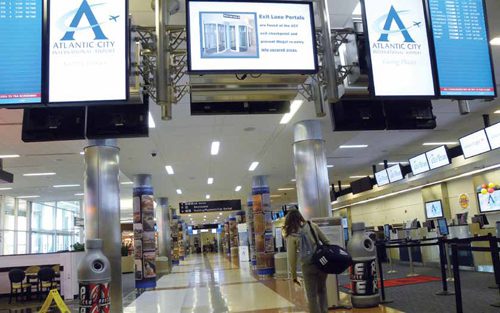
How does an airport meet the needs of current and future passenger growth without expanding its facilities? At Atlantic City International Airport (ACY), officials expanded virtually by upgrading the facility’s information technology systems.
|
factsfigures Project: Improvement of IT Business Processes Location: Atlantic City (NJ) Int’l Airport Approximate Cost: $3.5 million Funding: Passenger Facility Charges Approximate Timeline: 4 years (design to operation) Prime Consultant: Arora Engineers Prime Design Build Contractor: Infax, Inc. Design Support: The Sheward Partnership Common Use: ARINC Airport Operational Database, Resource Mgt. System & Gate Mgt. Modules: Ascent Technology Flight Information Display System: Infax FIDS Monitors: NEC Revenue Management System: ALFA FIS Engineers: TPD Architects, XIP Consulting |
With the projects came new counters and back walls for 30 total positions. The area was also fit out for future bag drop locations. Five ultra-thin bezel video walls and more than 100 FIDS displays were installed per the design developed by The Sheward Partnership in cooperation with the airport and lead consultant Arora Engineers.
ACY worked with a number of vendors on the project to get a system that met all of its needs. Infax, Inc. acted as the prime design-build contractor and also provided the FIDS, baggage information display system and visual paging. Common use check-in system aspects were provided by ARINC; the AODB and RMS (gate and ticket counter management) were provided by Ascent Technology; the revenue management system came from ALFA; and the FIDS monitors were provided by NEC.
Allowing the integrators (Infax, etc.) to work as design-build contractors instead of as sub contractors to the electrical contractor reversed the traditional roles, relates Manik Arora, PE, president/CEO of Arora Engineers.
 “That was unique,” says Arora. “It transferred the risk of technology and integration to the prime, which is where it’s supposed to be … usually the prime doesn’t understand what’s going on.” By allowing the integrators a broader view of/responsibility for the project, he explains, they were better able to ensure that the project was completed correctly.
“That was unique,” says Arora. “It transferred the risk of technology and integration to the prime, which is where it’s supposed to be … usually the prime doesn’t understand what’s going on.” By allowing the integrators a broader view of/responsibility for the project, he explains, they were better able to ensure that the project was completed correctly.
“We put together an experienced and proven team for all portions of the project ensuring that the clients’ technological and financial aspects could be met,” explains Mike Davis, president of Infax, Inc.
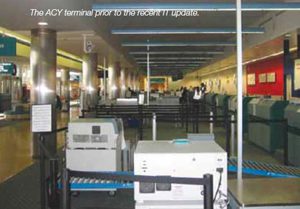 Considering Common Use
Considering Common Use
Due to architectural factors limiting the expansion of ACY’s ticket counter area, the airport was trying to devise ways to increase the space without having to build too much. Not surprisingly, common-use technology was suggested. A large number of charters using the airport further fueled the interest, explains airport director Tom Rafter.
 “We may have to put a lot of different charter carriers through a small area and get better utilization with that space,” Rafter says.
“We may have to put a lot of different charter carriers through a small area and get better utilization with that space,” Rafter says.
Arora and his staff helped educate officials about how common use could benefit ACY. Small airports, he explains, often have more flexibility for updating their FIDS. In addition, their use and lease agreements may offer more opportunities to introduce common-use systems.
“We realized the passenger experience was really the airport’s responsibility,” says Rafter, “(but) it was always left on the airlines … (the airport) always relied on the airlines to tell them if a flight landed, and if it didn’t, the passenger was frustrated. Now they took back the responsibility to manage that data.”
Arora and airport officials traveled the country researching how common use works at other major airports. “We saw the bigger picture, how they did things, how resources are allocated,” recalls Arora.
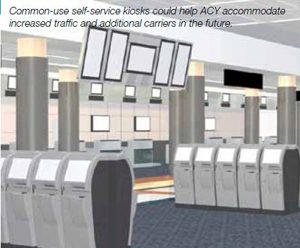 A limited pilot program was recently launched to explore whether common use is right for ACY. The pilot program will also put the airport in position to implement common use on a wider basis if the market dictates, explains Joel Falk, director of information and toll technology for the South Jersey Transit Authority.
A limited pilot program was recently launched to explore whether common use is right for ACY. The pilot program will also put the airport in position to implement common use on a wider basis if the market dictates, explains Joel Falk, director of information and toll technology for the South Jersey Transit Authority.
With six more gates currently under construction and a new federal inspections station scheduled to begin providing 24/7 customs and border control service next year, Falk sees the possibility of needing common-use systems to manage additional traffic from new service. “We’ll need common use to solve our capacity issues; and if that time comes, we’re confident we’ll be in a good place to do that,” he relates. “We did build a back office, we do have some pilot ticketing and gate stations that we can use. We won’t be starting from scratch if that day comes.”
 Rafter and Falk identify carrier buy-in as a challenge to adopting common-use systems – especially since the AirTran/Southwest merger. “One is a common use fan and the other is not,” Rafter explains. Southwest doesn’t like common use because of the way it boards passengers, notes Davis.
Rafter and Falk identify carrier buy-in as a challenge to adopting common-use systems – especially since the AirTran/Southwest merger. “One is a common use fan and the other is not,” Rafter explains. Southwest doesn’t like common use because of the way it boards passengers, notes Davis.
Falk acknowledges that it has been difficult establishing proper connections with some carriers’ host systems. And although he understands that some airlines view common use as a bothersome change, the new technology will help the airport attract new service. “They can come in and conduct flight operations without having to make a big IT investment,” he explains. “So it’s kind of a nuance for folks that are at ACY today; but we feel that it’s important as a platform for new future carriers.”
IT Updates
Falk describes the new airport operations database as “sitting in the middle, storing and sharing information that is used among the different components.”
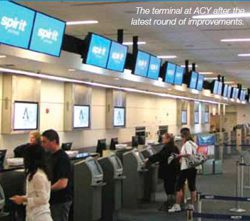 The resource management system, he adds, helps airport ops schedule and assign gates and ticket counters. Once that’s done, the associated information populates the FIDS and Airport Landing Fee and Revenue Management Software (ALFA) billing application used to collect landing fees.
The resource management system, he adds, helps airport ops schedule and assign gates and ticket counters. Once that’s done, the associated information populates the FIDS and Airport Landing Fee and Revenue Management Software (ALFA) billing application used to collect landing fees.
The AODB will be critical to common use, he notes.
In the airport’s pilot test, once a carrier is assigned a ticket counter or gate position, the equipment triggers the systems to serve that airline for the duration of a given flight operation. The back screens show its logo, the telephones are dedicated to that particular airline and the computers are networked to its home office. “Of course, when they are done and log off, I can then use the RMS to assign that gate to (another airline),” Falk explains, noting that the other airline’s logo lights up on the back wall and the phones and computers are redirected to serve the new designee. “This AODB is kind of this behind-the-scenes expediter; that’s where all the pieces come together,” he relates.
The AODB, and the modules it feeds, were added to improve efficiencies and help handle large spurts of traffic, Rafter adds. The ALFA program, which includes electronic invoicing, is not intended to eliminate jobs, he explains; it’s meant to help existing staff increase their output.
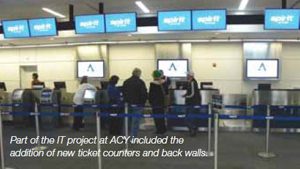 Designing around new FIDS monitors was somewhat challenging, but has gotten easier in recent years due to the shrinking sizes of central processing units, explains Michael Sheward, principal of The Sheward Partnership.
Designing around new FIDS monitors was somewhat challenging, but has gotten easier in recent years due to the shrinking sizes of central processing units, explains Michael Sheward, principal of The Sheward Partnership.
“The tolerances on everything have gotten much tighter, so it’s helped us,” Sheward explains. “It used to be that there were those large TVs with the big tubes … FIDS that were almost two feet deep. Today, it definitely frees it up and you can do a lot more interesting things.”
Better Info
The new revenue management system will also be of great benefit to the airport, Arora says. He explains that the new software allows the system to capture assets such as gate and ticket counter utilization that weren’t previously captured.
The flight data itself, he adds, is much more accurate because airlines can now update for diversions or late flights. “They didn’t have that ability before,” he comments. “It was all coming from the airlines’ host systems.”
ACY’s many charter operators now have the ability to assign seats and track passengers much like major airlines do, he adds. Previously, they had to rely on logs from travel or tour agents.
Rafter expects the new systems to significantly reduce workloads in several departments – by automating information collection for billing landing fees, for instance. Performance of the new system, however, hasn’t been measured yet because it’s currently running alongside the previous one while employees ensure everything is working properly.
Rafter considers the FIDS one of the projects’ major successes. “We have a tremendous amount of information that we’re putting out there in the various parts of the terminal for the departing and arriving passengers,” he remarks.
Advertising Advantage
ACY also implemented a digital signage program, which officials plan to leverage to the casino market for advertising, Arora says. In addition to displaying wayfinding information and visual paging, ACY also runs advertisements for airport concessions on the five large, flat screen video walls.
“The appearance is tremendous,” notes Rafter. “It has so much great potential.”
Per the suggestion of a staff member, the airport may display trivia questions to educate passengers about the airport and keep them entertained while they wait in line.
Future Projects
Developing offsite passenger processing at local casinos is a long-term goal at ACY. “The casinos are ready to fund the project because we can keep the passenger there to gamble an hour more. That’s where this is headed,” reports Arora. “The airport is extending itself out to the community, and this is a mature market for doing that.”
“The casinos would like to have a seamless experience for their customer,” adds Rafter. “Ultimately, we’d like for passengers to be able to check out of their room, leave their bags and check into their flight.”
The airport’s current self-serve check-in pilot could pave the way. “We designed our ticket counters with special bag drop areas that we envision as being potential self-service customer bag drops,” Falk explains. “We very much would like to extend this model off property. For example, the airport could put self-service check-in kiosks at the casinos and then find a way to properly, per TSA regulations, have custody of that bag as it comes to the airport.”
Assuming the airport secures TSA involvement, Rafter is optimistic about the possibility: “They’ve done it in Orlando and Vegas and other places. It’s more driven by the casinos than us.”
With time and collaboration, he sees offsite processing as a viable option for ACY in the future.


